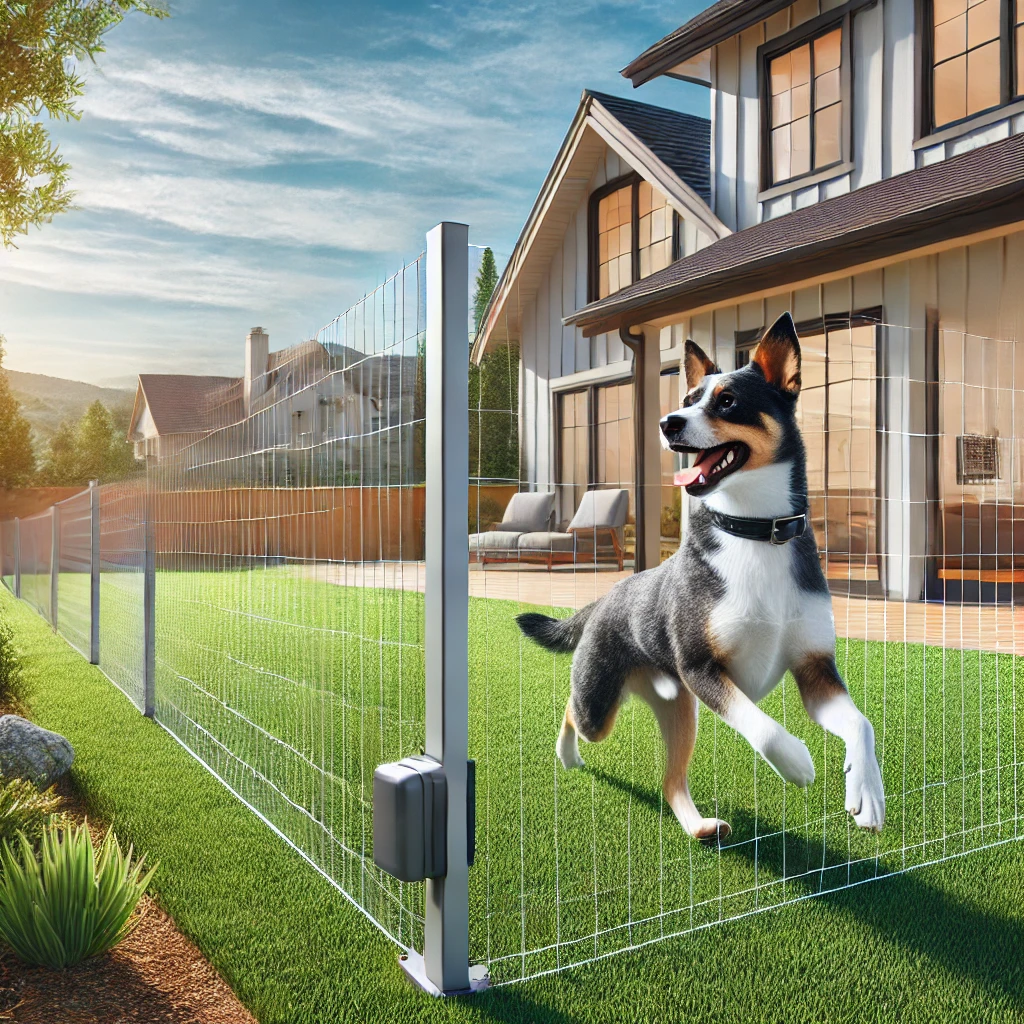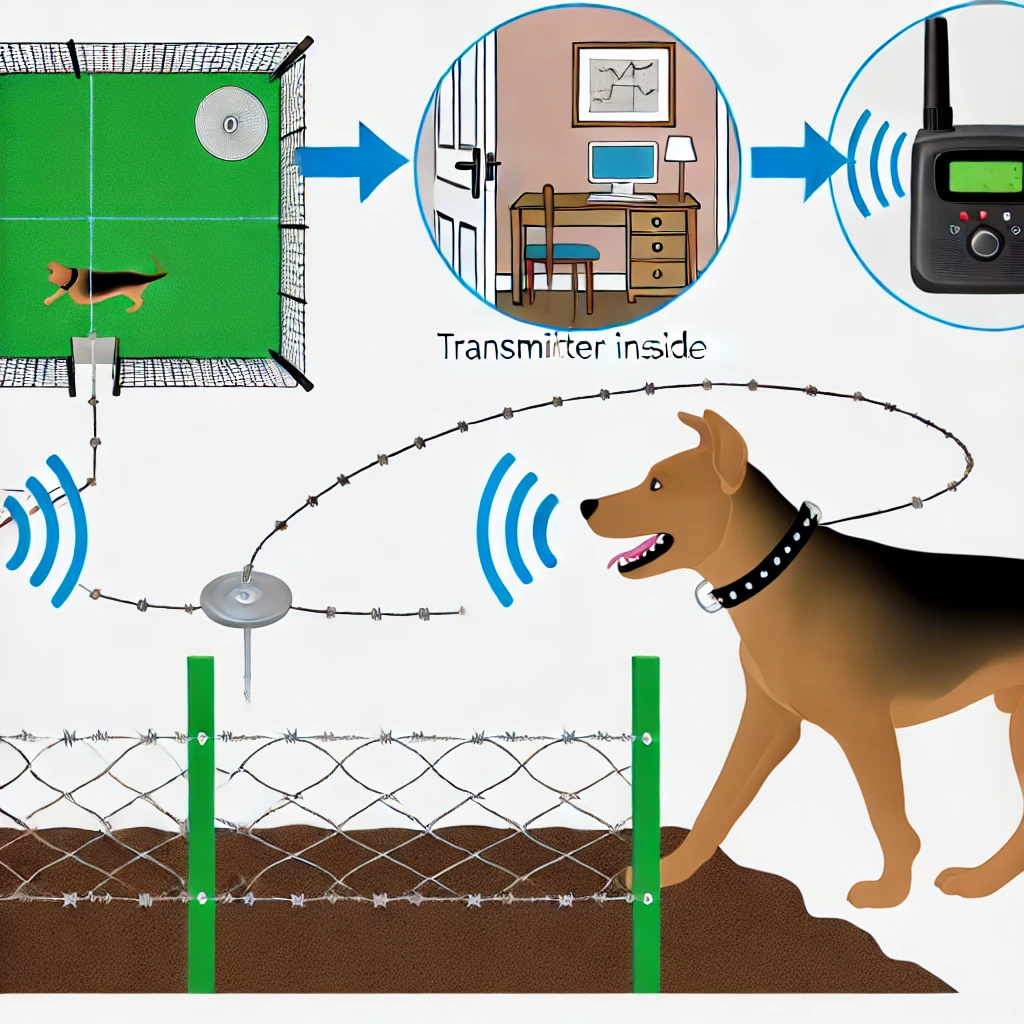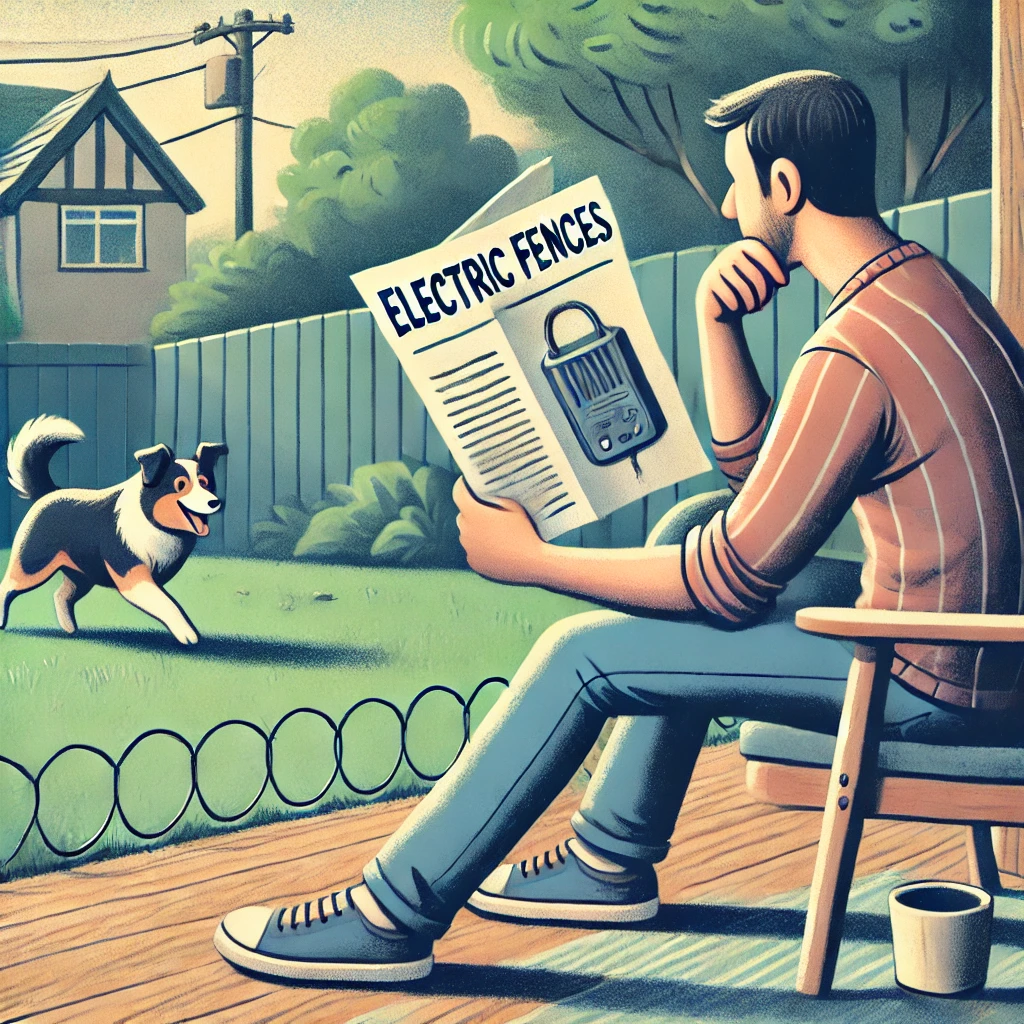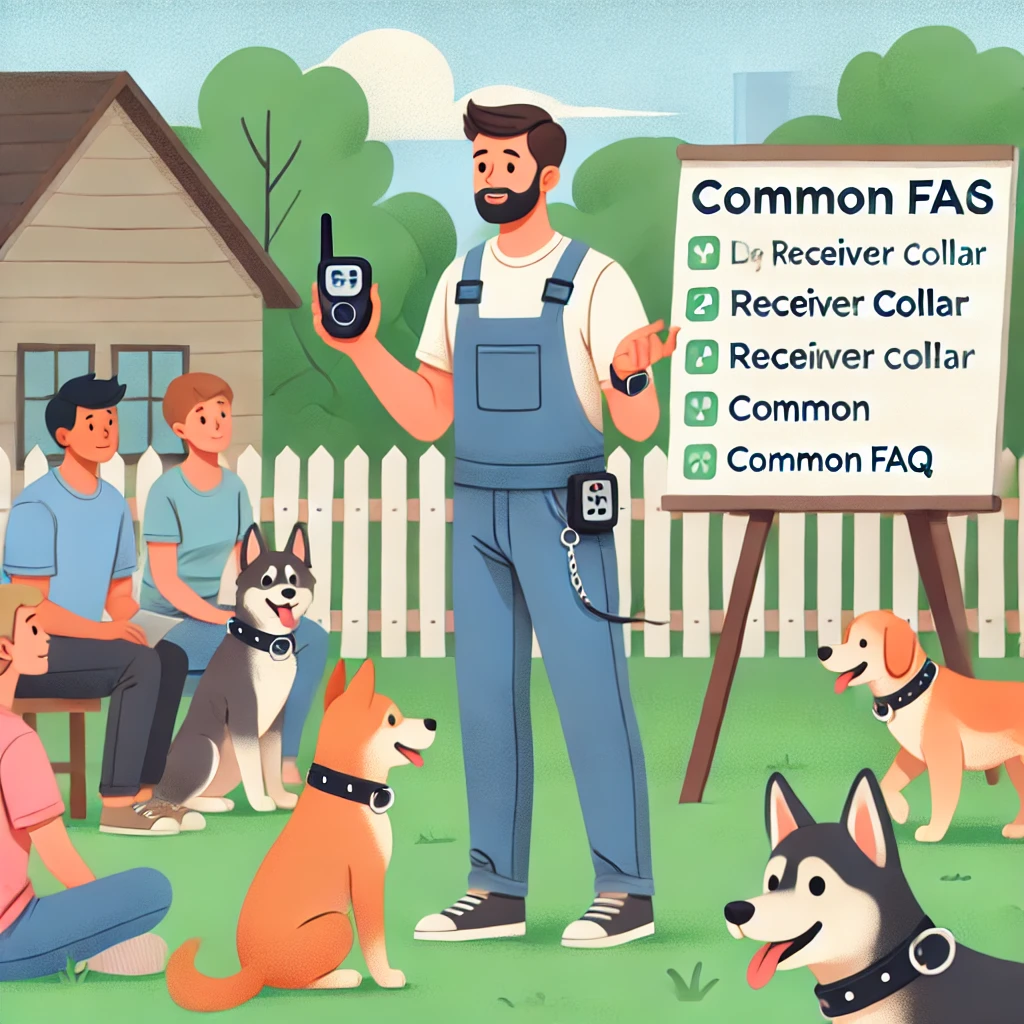
When it comes to keeping your pet safe and secure within the boundaries of your property, many pet owners consider an electric fence for dogs.
These invisible barriers are designed to keep your dog contained without the need for traditional physical fencing.
But is an electric fence for dogs the right choice for you and your pet?
In this comprehensive guide, we will explore the pros and cons of using an electric fence for dogs, helping you make an informed decision based on your dog’s needs, your property, and your lifestyle.
What Is an Electric Fence for Dogs?
An electric fence for dogs is a containment system designed to keep dogs within a designated area without the need for a physical barrier.
It typically works by using a combination of a transmitter, buried wires (for in-ground systems), and a receiver collar worn by the dog.
The fence creates an invisible boundary around your property.
If your dog crosses this boundary, the collar delivers a mild electric shock to remind them to stay within the limits.
Electric fences come in different types, including wired (in-ground) and wireless systems.
They are a popular choice for pet owners who want to avoid the cost and aesthetic drawbacks of traditional fencing.
However, like any pet containment system, there are advantages and disadvantages to using an electric fence for dogs.
In this post, we will break down the pros and cons of electric fences, explore different types of systems, and discuss factors to consider before deciding if this solution is right for your pet.
1. How Does an Electric Fence for Dogs Work?

Understanding how an electric fence for dogs works can help you determine if it’s a good fit for your home. The system typically includes:
- Transmitter: This device generates the signal that creates the invisible boundary. It is often installed inside your home or garage.
- Wire (for in-ground systems): The wire is buried underground along the perimeter of your property, creating a boundary where the dog should not pass.
- Receiver Collar: The dog wears a receiver collar that communicates with the transmitter. If the dog approaches the boundary, the collar gives an audible warning beep. If the dog continues to move toward the boundary, the collar administers a mild electric shock.
There are also wireless electric fence systems that do not require wires to be buried. These systems create a circular boundary around the transmitter.
2. The Pros of Using an Electric Fence for Dogs

Electric fences offer several advantages that appeal to pet owners who want to contain their dogs without building a physical fence.
a. Cost-Effective
One of the biggest advantages of an electric fence for dogs is that it is much more cost-effective than traditional fencing.
Installing a wooden or chain-link fence around your property can be expensive, especially if you have a large yard.
Electric fences, on the other hand, can be installed for a fraction of the cost.
b. Aesthetic Appeal
For homeowners who are concerned about the appearance of their property, an electric fence offers a clean and invisible solution.
There is no need for tall, unsightly barriers that may obstruct views or clash with your landscaping.
This is particularly appealing for those living in scenic areas or neighborhoods with strict HOA regulations on fencing.
c. Flexibility and Customization
Electric fences are highly flexible and can be customized to fit the layout of any property.
Whether you have an odd-shaped yard or need to avoid certain areas (like gardens or pools), electric fences can be designed to fit your needs.
For in-ground systems, the wire can be buried to outline the exact boundaries you want your dog to stay within.
d. Safety for Active Dogs
If you have an active dog that loves to run and explore, an electric fence can provide the space they need to roam while keeping them safe.
Dogs can exercise freely within the boundaries without the risk of wandering into traffic or getting lost.
e. Easy to Install
Compared to the installation process of building a physical fence, setting up an electric fence for dogs is relatively simple and quick.
Many pet owners can even install the system themselves, especially if opting for a wireless model.
f. Protection for Your Dog
An electric fence can prevent your dog from chasing after wildlife, cars, or people passing by.
This can be especially helpful for breeds that have strong prey drives or tend to run off when excited.
The boundary training helps keep your dog safely contained within your yard.
3. The Cons of Using an Electric Fence for Dogs

While there are many benefits to using an electric fence for dogs, it’s important to consider the potential drawbacks before making a decision.
a. Discomfort or Stress for the Dog
The most significant downside to an electric fence for dogs is the discomfort caused by the electric shock.
While the shock is typically mild and not intended to harm the dog, it can still be distressing, especially for sensitive or anxious dogs.
Some dogs may become fearful of the fence or even refuse to go outside after receiving the shock.
b. No Protection from External Threats
An electric fence keeps your dog in, but it doesn’t keep other animals or people out.
This means your dog could still be vulnerable to attacks from stray dogs, wild animals, or even theft if your yard is not fully enclosed by a physical barrier.
c. Not 100% Effective for All Dogs
Some dogs, especially those with strong-willed or high-prey instincts, may ignore the shock and run through the fence if they are determined enough.
Once they are outside the boundary, they may not want to come back due to the shock when re-entering the property.
This is especially common in larger or more stubborn breeds.
d. Requires Consistent Training
Training is essential when using an electric fence for dogs.
Pet owners must dedicate time to teaching their dogs where the boundaries are and ensuring they understand the consequences of crossing them.
Without proper training, the system will not be effective.
e. Power Outages and Malfunctions
Electric fences rely on electricity to function, so they can become useless during a power outage or if the system malfunctions.
If the fence stops working and your dog isn’t aware of it, they could easily wander out of the yard.
f. Limited Mobility for Dogs with Certain Needs
For dogs with certain physical conditions or older dogs, an electric fence may not be the best option.
The shock could exacerbate existing health issues, and the boundary training may be too difficult for them to grasp.
4. Types of Electric Fences for Dogs

There are different types of electric fences for dogs, each with its own features and benefits.
a. In-Ground (Wired) Electric Fences
This type of electric fence requires burying a wire along the perimeter of your property.
The wire creates the invisible boundary, and the collar communicates with the wire to deliver a shock if the dog crosses it.
In-ground fences are ideal for custom-shaped yards and provide more control over where the boundaries are set.
b. Wireless Electric Fences
Wireless electric fences create a circular boundary around a central transmitter.
There are no wires to bury, and the system is easy to set up.
However, the boundary is always circular, which may not work well for irregularly shaped yards.
c. Hybrid Electric Fences
Some systems combine elements of both in-ground and wireless fences, offering flexibility for pet owners who need both customization and ease of installation.
5. Is an Electric Fence Right for Your Dog? Factors to Consider
Before deciding whether an electric fence for dogs is right for your pet, consider the following factors:
a. Your Dog’s Temperament
Some dogs are more sensitive to the shock and may not respond well to the training.
If your dog is anxious, timid, or has a history of fear-related behaviors, an electric fence may cause more harm than good.
On the other hand, confident and energetic dogs may benefit from the freedom an electric fence provides.
b. Size of Your Yard
If you have a large yard, an electric fence can be an effective way to give your dog plenty of room to roam.
However, if your yard is small or unusually shaped, a wireless fence may not provide enough flexibility to set the boundaries where you need them.
c. Budget
Electric fences are more affordable than traditional fences, but there are still costs involved in purchasing and maintaining the system.
Additionally, in-ground fences require more effort and resources for installation compared to wireless models.
d. Local Regulations
Before installing an electric fence, check your local laws and regulations regarding pet containment systems.
Some areas may have restrictions on using electric fences, particularly if your property is close to public areas or other homes.
Top 5 Electric Fences for Dogs

When deciding whether to invest in an electric fence for dogs, it’s helpful to know which brands and systems are the most reliable.
Here are the top five electric fences for dogs, based on customer reviews, ease of installation, durability, and effectiveness in keeping pets safe.
1. PetSafe Wireless Containment System
The PetSafe Wireless Containment System is one of the most popular and widely-used wireless electric fences for dogs.
Its easy installation and portability make it a top choice for pet owners who want a flexible, hassle-free solution.
- Type: Wireless
- Range: Adjustable circular boundary up to ½ acre
- Features:
- No wires to bury
- Portable for use on vacation or different properties
- Five adjustable levels of static correction, plus a tone-only mode for training
- Waterproof receiver collar with a long battery life
- Best For: Pet owners who need a simple and portable system. It’s ideal for small to medium-sized yards with straightforward circular boundaries.
Pros:
- Easy to set up and move
- No digging required
- Suitable for multiple dogs (with extra collars)
Cons:
- Only creates circular boundaries
- Limited range compared to in-ground systems
2. Extreme Dog Fence Professional Grade System
The Extreme Dog Fence Professional Grade System is an in-ground electric fence known for its durability and reliability, even in extreme weather conditions.
This system is highly customizable, making it perfect for pet owners with large or uniquely shaped properties.
- Type: In-Ground Wired
- Range: Covers up to 6 acres
- Features:
- Thick, heavy-duty wire that’s designed for durability
- Waterproof and submersible collar (up to 10 feet)
- Includes a 1-year warranty that extends to 10 years if registered
- Adjustable correction levels
- Best For: Pet owners with large properties or those looking for a long-lasting, highly durable containment system.
Pros:
- Customizable boundary shapes
- Strong and weather-resistant components
- Large coverage area
Cons:
- More difficult and time-consuming to install
- Requires digging to bury the wire
3. SportDOG Brand In-Ground Fence System
The SportDOG Brand In-Ground Fence System is designed for active, energetic dogs who need a large area to run.
This system offers excellent range and is expandable to cover up to 100 acres with additional wire.
- Type: In-Ground Wired
- Range: Covers up to 1 ⅓ acres (expandable to 100 acres)
- Features:
- Waterproof collar with built-in tone and vibration warnings
- Four levels of static correction, plus a tone-only mode
- Expandable for larger properties and multiple dogs
- Comes with a two-year warranty
- Best For: Dog owners with large properties or multiple dogs who enjoy outdoor activities.
Pros:
- Excellent for large properties
- Expandable range
- Durable and reliable
Cons:
- Requires burying the wire
- Larger upfront investment for extensive coverage
4. PetSafe YardMax Rechargeable In-Ground Fence
The PetSafe YardMax Rechargeable In-Ground Fence is designed with innovative features that maximize yard space for dogs.
It offers a highly effective and customizable containment system while minimizing the shock correction area, allowing your dog to roam freely without hitting the boundary too early.
- Type: In-Ground Wired
- Range: Covers up to 10 acres
- Features:
- Rechargeable collar with long-lasting battery life
- Unlimited boundary range with additional wire
- Provides warning tone before correction is applied
- Suitable for smaller yards and larger properties
- Best For: Homeowners who want to maximize their yard space for their dogs while ensuring effective containment.
Pros:
- Rechargeable collar (no need for replacement batteries)
- Extended roaming area for dogs
- Customizable boundary layout
Cons:
- Requires wire installation
- Slightly more expensive than basic systems
5. Sit Boo-Boo Advanced Electric Dog Fence
The Sit Boo-Boo Advanced Electric Dog Fence is an affordable in-ground electric fence system that’s easy to set up and designed to meet the needs of average-sized properties.
With a user-friendly design and adjustable correction levels, it’s a solid choice for most pet owners.
- Type: In-Ground Wired
- Range: Covers up to 1.2 acres (expandable)
- Features:
- Waterproof, adjustable collar with five levels of static correction
- Durable wire that’s designed for longevity
- Simple DIY installation
- Lifetime warranty and 24/7 customer support
- Best For: Pet owners looking for an affordable, reliable, and easy-to-install in-ground system.
Pros:
- Budget-friendly
- Easy installation
- Expandable coverage
Cons:
- Not as robust as some premium systems
- Coverage area is limited unless additional wire is purchased
Which Electric Fence for Dogs is Right for You?

Choosing the right electric fence for dogs depends on your property size, budget, and your dog’s temperament.
If you need flexibility and ease of installation, a wireless fence like the PetSafe Wireless Containment System may be the best option.
For larger properties or owners looking for a durable, long-lasting system, in-ground fences like the Extreme Dog Fence Professional Grade or SportDOG In-Ground System are excellent choices.
Each of these top five electric fences offers unique features and benefits to suit a range of needs.
Whether you’re seeking affordability, large coverage areas, or advanced features, there’s a system that will help keep your dog safe and secure within the boundaries of your yard.
Conclusion: Weighing the Pros and Cons of an Electric Fence for Dogs
Deciding whether an electric fence for dogs is right for your pet requires careful consideration of your dog’s personality, your property, and the potential risks and benefits.
While an electric fence can offer a cost-effective and aesthetic way to contain your dog, it also comes with its challenges, including the potential discomfort for your dog and the need for consistent training.
If you’re willing to put in the time to train your dog properly and have a large yard that benefits from the flexibility of an electric fence, this could be a great solution.
However, if your dog is particularly sensitive or you need to protect them from external threats, a traditional fence might be a better option.
Ultimately, the decision comes down to what works best for both you and your dog.
By understanding the pros and cons of an electric fence for dogs, you can make an informed choice that keeps your pet safe and happy.
FAQs: Electric Fence for Dogs

1. Is an electric fence safe for my dog?
Yes, electric fences are designed to be safe for dogs.
The shock delivered by the collar is mild and intended to deter your dog from crossing the boundary, not harm them.
However, it’s important to use the system according to the manufacturer’s instructions and ensure your dog undergoes proper boundary training to avoid unnecessary shocks.
2. How long does it take to train a dog to use an electric fence?
Training typically takes around 2 to 3 weeks, depending on your dog’s temperament and willingness to learn.
It’s important to follow a consistent training schedule and use positive reinforcement, such as treats and praise, when your dog respects the boundary.
Start with the warning tone function before introducing the shock.
3. Can a dog run through an electric fence?
Yes, in some cases, a determined dog may run through an electric fence, especially if they are chasing something like a squirrel or another dog.
Once they are outside the boundary, they may not want to come back due to the shock when re-entering.
This is why consistent training is essential, and owners of high-prey drive dogs should monitor their pet’s behavior.
4. Will an electric fence keep other animals out of my yard?
No, electric fences are designed to keep your dog in but do not prevent other animals, like stray dogs or wildlife, from entering your yard.
For protection from external threats, a physical fence may be necessary.
5. Can an electric fence be used with any size dog?
Most electric fence systems can be used with dogs weighing at least 8 pounds.
Larger dogs may require collars with higher levels of correction, but it’s important to choose a system with adjustable settings to match your dog’s size and sensitivity.
6. What happens if there is a power outage?
During a power outage, an electric fence will stop working.
Some systems have backup battery options to ensure the fence continues to operate for a short time.
If your area experiences frequent power outages, it’s a good idea to invest in a backup power source or consider a system with a battery-operated transmitter.
7. Can I install an electric fence myself?
Yes, many electric fence systems are designed for easy DIY installation.
Wireless fences, in particular, are quick to set up, while in-ground systems may take more time due to the need to bury the wire.
However, with the right tools and instructions, most pet owners can install the fence on their own.
8. Do electric fences work in all weather conditions?
Electric fences are generally weather-resistant, and most systems work well in rain or snow.
However, extreme weather conditions, such as heavy snow or ice, may affect the effectiveness of the system.
It’s important to regularly check the system and ensure that the collar and transmitter are functioning properly in all conditions.
9. Can I use an electric fence if I have multiple dogs?
Yes, most electric fence systems are designed to work with multiple dogs.
You simply need to purchase additional collars for each dog.
Some systems allow you to customize the correction level for each collar, making it easy to manage dogs with different sizes or temperaments.
10. Are there alternatives to electric fences?
Yes, alternatives to electric fences include physical fences (such as chain-link, wood, or vinyl fences), long leashes or tethers, and outdoor dog enclosures. Additionally,
if you’re concerned about the discomfort caused by electric fences, you might consider using a GPS-based wireless fence system that doesn’t rely on electric shocks.
Related Articles:
Dog Treadmill vs. Outdoor Walks: Which Is Better for Your Pup?
Top 10 Outdoor Dog Kennel Designs to Keep Your Pet Secure and Comfortable
As an Amazon Associate, I earn from qualifying purchases.


